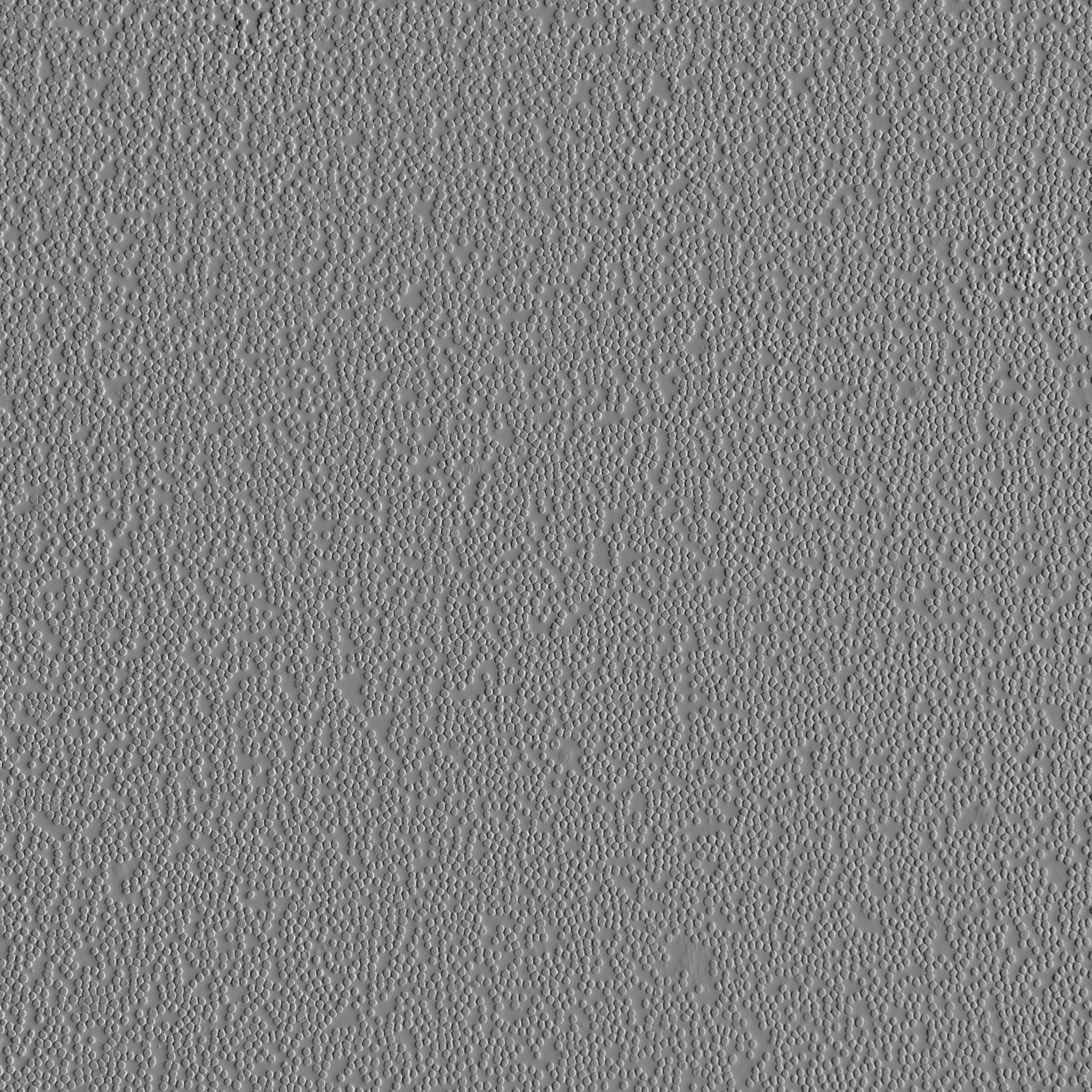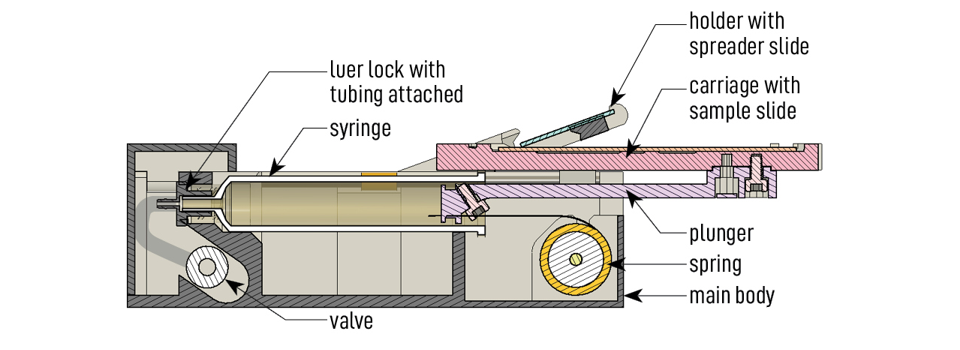Inkwell
ABSTRACT
Microscopy plays a crucial role in hematology and diagnosis of infectious diseases worldwide. For malaria alone, more than 200 million slides are read by manual microscopists every year. High quality thin blood smears are essential for subsequent microscopy examinations including malaria microscopy, but are hard to make in field settings. Existing devices for assisting in making thin smears are available but are limited by cost or complexity for wider use. Here we present Inkwell, a portable mechanical device capable of making high quality thin blood smears in field settings. Inkwell is simple, low-cost, does not use electricity, and requires minimal training prior to use. By utilizing passive dissipative dynamics of a spiral spring coupled to an air dashpot with a tunable valve - we demonstrate a highly tunable mechanism for constant velocity smears at prescribed angle. Inkwell is capable of producing high quality blood smears of tunable cell density with more than 12 million individually distinguishable red blood cells on a single slide. The current design, which exploits precision manufacturing of a 17 cents plastic syringe and a spring, can be printed on a standard 3D printer with overall unit cost of less than a few dollars in large quantities. We further present usability tests to confirm performance over 10,000 unit cycle operations with no degradation in quality of the smear and demonstrate ease of use with minimal training. Inkwell enhances the broader toolbox of open innovations in diagnostics for providing high quality medical care in low and medium resource settings. Combined with rise of 3D printing, Inkwell presents an alternative to traditional centralized manufacturing and opens up distributed manufacturing of medical diagnostics in global context.
BIG QUESTION
“How can we aid technicians with varying skill levels in producing consistent high-quality thin smears in the field using only simple, low-cost parts?”
Slides imaged per year:
100-200 million
slides
Comparable product cost:
$1000
per unit
Inkwell cost:
$15
per unit
Inkwell smears have up to:
13-16 million
red blood cells
What is Inkwell?
Microscopy plays a crucial role in diagnostics of infectious diseases. For malaria alone, 100 to 200 million slides are read by microscopists every year. High-quality thin blood smears enable speciation and measurement of parasitemia but are hard to make in field settings. A large number of smears produced globally are still done by hand, which leads to high variability in smear quality (i.e. overlapping cells, very low cell density, sheared cells, etc), which makes the detection of parasites more difficult and more prone to human errors. Although equipment that can produce quality thin smears exist, they are either extremely expensive or require electricity, which makes them inaccessible for use in remote settings, especially in the LMIC context. Designed for the most remote field sites, Inkwell is a low-cost and simple device that can purely mechanically create a perfect thin smear every time with little to no user experience and without the use of any motors or electricity.
All parts are made from easily accessible off-the-shelf components and simple 3D-printing approaches for reproducibility. The current design of Inkwell [ref github] has three main sub-assemblies: (1) a static base, (2) a traveling carriage that holds the sample slide, and (3) a spreader holder hinged on the base. To operate Inkwell, first ensure that the carriage is retracted, then place a glass slide (sample slide) on the carriage and place another glass slide (spreader slide) onto the holder. Then, apply a drop of blood (~4-6uL) onto the designated spot on the sample slide. Finally push the carriage as far in as possible and release - allow the carriage to return to its retracted position on its own. The smear produced should exhibit a thin film which covers the majority of the slide. The sample slide can then be removed for further processing (i.e. fixing, staining) and eventually imaged.
Door-to-door healthcare workers making blood smears in the field.
Latest Inkwell iteration
How does it work?
The mechanism of Inkwell lies in the spring, piston, and valve combination, allowing for controlled velocity for making the thin smear. The traveling carriage is actuated by a constant-force spring and damped by a vacuum pressure in the form of tunable airflow. While traditionally, this is done by using a dashpot, an ultra-low friction graphite piston costing ~$80 per unit, Inkwell uses a lubricated plastic syringe (~$0.20/unit) fitted with an adjustable needle valve ($0.50/unit), which can provide comparable smooth dampening. The tunable valve allows the user to further calibrate the desired density and thickness of the smears produced. Metal rods and sleeve bearings, along with adequate syringe lubrication, allow for extra smooth travel.
The spreader holder can be easily adjusted to various angles, while gravity and a level mechanism are sufficient to keep contact between the spreader slide and the sample slide. This constant contact is critical to produce an even smear, pulling the meniscus of RBCs along the length of the slide.
Data
Good thin smears are defined as having a large area in which RBCs are monolayered and densely packed, with very little overlapping. Evaluating thin smears made by hand versus using Inkwell, we found Inkwell smears exhibit an average cell density of 13k-16k cells/mm2 and a 97-97% slide coverage of monolayered RBCs, resulting in 13-16 million distinguishable RBCs, as compared to smears made by hand with 2.8k-4.4k cells/mm2, a mere 20-40% slide coverage, and a total of 2.8-4.4 million RBCs, respectively.*
To test the durability of Inkwell, we built a stress-test machine which simulates a technician operating Inkwell over thousands of cycles. The smears produced using a newly-built Inkwell compared to one that had undergone 10,000 cycles are comparable and are good quality smears.
*Smears done on Inkwell were produced using both human whole blood with anticoagulant agents and fresh finger-prick blood.
Scan of thin smear produced on Inkwell, 2D and 3D heatmaps showing cell density
Next Steps
We’ve produced the latest functional set of Inkwell prototypes. We plan to build 100 Inkwells in the next few months and deploy them at partner field sites for onsite tool validation.
Project Collaborators
We’ve collaborated with a number of groups on testing initial prototype version of Inkwell. The list of collaborators will eventually grow with the upcoming validation test.
This project is currently funded by Gordon and Betty Moore Foundation, Bill & Melinda Gates Foundation, Google, and Chan-Zuckerberg Biohub.










